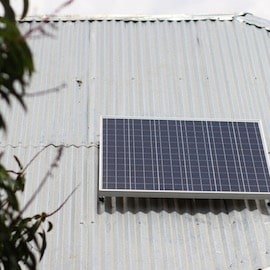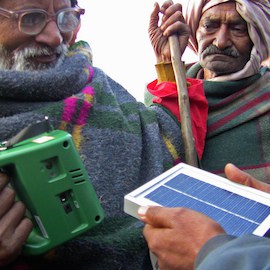Hype in the Energy Access Sector (Finally!)
On March 27, NextBillion published a piece entitled “An Impact Investor Urges Caution on the ‘Energy Access Hype Cycle.’” The piece, written by Ceniarth’s Greg Neichin, Diane Isenberg and Mary Roach, raises serious concerns about over-hype and underperformance in the energy access sector.
We applaud Ceniarth’s piece and welcome the views of an investor that looks at this promising sector with a critical eye. We are, however, compelled to explain why we strongly disagree with their analysis.
What do we mean by the term “energy access sector”? This reference is to businesses that sell solar home systems to off-grid households and businesses on credit. They do so using locking mechanisms remotely controlled via mobile phone networks, mobile money payments and cloud-based management systems. The combination of these innovations has made an affordable product available to even low-income households that are today paying approximately $7 a month for kerosene to light their homes. Over the past six years several companies have collectively reached several million people using these innovations and business models; their goals are to scale to many more millions of people.
Now, let’s look at the concerns raised by Ceniarth:
- Investor over-exuberance. Too much capital is flowing into the energy access sector. The concern is that expectations are too high and that venture capital incentives are misaligned (presumably the misalignment is between venture capitalists’ objectives and sector needs). Ceniarth believes that this portends “a broader hype cycle curve and we do not like the trajectory of that ride.”
While there is some hype about investing in the handful of established companies, our biggest concern is that not enough capital is flowing into the sector to give it the opportunity to prove itself. One must remember that the energy access sector is “asset heavy” – companies finance customer purchases of otherwise unaffordable solar home systems. Citing Bloomberg New Energy Finance’s data that $200 million was invested in the energy access sector in 2016, the Ceniarth authors imply that this number itself is a sign of an overheated investor base. We estimate that $200 million raised in 2016 will prime the pump to reach just over 1 million households and businesses in 2017 (with an average investment of $150 per household). But that’s a penetration of less than 1 percent of the potential market in sub-Saharan Africa. Keep this in perspective: it took several billion dollars per year for a decade to enable the mobile phone industry to reach 75 percent of sub-Saharan Africa. As such, $200 million is not investor hype – it’s closer to capital starvation.
There are likely companies in the sector that are weak, poorly managed or executing flawed business plans, and there are investors who may not appreciate the risks. While this is a reason for caution it is not a reason for investors to stop investing and for other stakeholders (governments, NGOs, development finance institutions, etc.) to abandon the sector. No one ever said that this would be easy. Nonetheless, we see opportunity and promise.
- Most companies operate in a grey area of regulation. Ceniarth asserts that “[m]ost companies in the energy access sector are operating in a grey area of regulation.” This statement is absolutely untrue. No company that Persistent Energy has invested in operates in a regulatory grey area in its country of operation. Full stop.
Perhaps Ceniarth’s real concern is consumer protection: Will energy access companies take advantage of consumers because they are unregulated monopolists? One can’t deny that human nature and market forces can lead to temptations of abuse. But we take a page from Western economic history – abuse was followed by revelations of abuse, which was followed by regulation. Industries evolved and good businesses thrived under regulation. We expect the same to occur in the evolution of the off-grid energy sector.
- Energy access companies will compete with each other. The article goes on to raise the concern that energy access companies will come under pressure to compete as they grow, perhaps relaxing credit standards or otherwise attempting to “flip” customers in a way that harms the sector.
We expect competition. It’s the free market’s answer to vendor market power over consumers and is often more effective than regulation. Competition will stress test energy access business models and help us learn how to grow this young market to the next stage. There will be winners and losers; certainly, consumers will win and so will enough companies to achieve a more robust marketplace in “energy access 2.0.”
In short, we don’t believe growing pains are reasons to give up on the most promising strategy for energy access in history. As we invest, we expect some of our investments to fail and others to succeed. But overall, we will have a profitable portfolio that gives investors an attractive social and financial return.
- The energy access business model is unprofitable if low-income customers are being served. Ceniarth says that by offering 24/7 customer service via call centers, skilled installation of systems, and field maintenance technicians, energy access businesses cannot be profitable focusing on customers that can only afford to shift their $7 a month energy spending to purchasing solar products. This, they believe, has caused companies to drift up market to more affluent customers to whom they can sell more expensive products. This has led Ceniarth to invest its capital in other types of firms such as One Acre Fund, which leverages its core farm distribution network to distribute solar products.
We remain convinced that energy access businesses targeting even the lowest-income consumers can and will be the backbone for profitable businesses. Several such businesses are already breakeven on an operating basis and are not profitable primarily because they continue building for growth. And while we admire One Acre Fund, we do not believe that ad hoc distribution networks will build off-grid energy distribution systems that will become the backbone of rural energy access. Only profitable businesses with field teams, call centers and cloud-based management systems will perform that function.
- The energy ladder leads nowhere. Ceniarth points out that low-income, off-grid consumers can’t afford to buy additional consumer products, whether they be larger solar home systems, appliances or other non-energy items. But this analysis misses the point: once a consumer pays off his solar home system, that system serves as collateral for additional purchases. The consumer can make the same monthly payments to buy additional products. The financial inclusion that is going on here is that, as a result of her first purchase of a solar home system, the consumer has both a good credit rating and collateral to pledge for her next purchase.
We understand changing investor perspectives. And we know firsthand that investing in this still young market is difficult and requires persistence. We believe we are clear eyed about the challenges. The sector has warts. There will be failures. Some investors will lose money. Yet, the sector has the promise of providing affordable clean energy, at scale, to millions of people in sub-Saharan Africa while achieving attractive financial returns. It can’t do this without adequate risk capital, and investors who are prepared to roll up their sleeves to participate in figuring out how to ensure its growth.
Chris Aidun and Dirk Muench are founders and partners at Persistent Energy Capital LLC, where Rodrigo Weiss is a partner.
Images courtesy of Persistent Energy
Homepage photo credit: SolarAid Photos, via Flickr.
- Categories
- Energy, Environment



